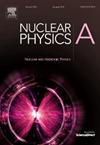The effect of three-body nucleon-nucleon interaction on the ground state binding energy of the light nuclei
IF 1.7
4区 物理与天体物理
Q2 PHYSICS, NUCLEAR
引用次数: 0
Abstract
We calculate the ground state binding energies of the light nuclei such as , , and by considering the effect of three-body nucleon-nucleon interaction. We use the effective two-body potential obtained from the lowest order constrained variational (LOCV) calculations of the nuclear matter for the , , , and nuclear potentials in different channels. To calculate the ground state binding energy, we implement the local density approximation by using the harmonic oscillator wave functions while the effect of three-body interaction is considered by employing the UIX potential. We compare the obtained two-body ground state binding energy with the energy related to the three-body effect. We also compare the obtained values with the experimental data and also work of others, and show that the results are relatively acceptable. We compute the root mean-square radius of the above nuclei for the , , , and potentials and compare the results with the experiment. We also obtain the contribution of different channels by matching to the experimental values of the quadrupole moments and magnetic dipole moments. Furthermore, we calculate the three-body cluster energy of the above nuclei and compare the results with that of nuclear matter. According to the obtained results, we see that the three-body cluster energy contribution is small. For example, for nuclide, this value is 0.079 MeV with the potential.
三体核子-核子相互作用对轻核基态结合能的影响
考虑三体核子-核子相互作用的影响,计算了H4e、L6i、C12和N14等轻核的基态结合能。我们利用核物质的最低阶约束变分(LOCV)计算得到的有效二体势对Reid68、AV14、UV14和AV18在不同通道中的核势进行了计算。为了计算基态结合能,我们利用谐振子波函数实现局域密度近似,同时利用UIX势考虑三体相互作用的影响。我们将得到的二体基态结合能与三体效应相关的能量进行了比较。我们还将所得值与实验数据和其他人的工作进行了比较,表明结果是可以接受的。我们计算了上述Reid68、AV14、UV14和AV18电位的均方根半径Rrms,并与实验结果进行了比较。通过对四极矩和磁偶极矩的实验值进行匹配,得到了不同通道的贡献。此外,我们还计算了上述核的三体团簇能,并与核物质的结果进行了比较。根据得到的结果,我们看到三体团簇的能量贡献很小。例如,对于H4e核素,该值为0.079 MeV,具有Reid68势。
本文章由计算机程序翻译,如有差异,请以英文原文为准。
求助全文
约1分钟内获得全文
求助全文
来源期刊

Nuclear Physics A
物理-物理:核物理
CiteScore
3.60
自引率
7.10%
发文量
113
审稿时长
61 days
期刊介绍:
Nuclear Physics A focuses on the domain of nuclear and hadronic physics and includes the following subsections: Nuclear Structure and Dynamics; Intermediate and High Energy Heavy Ion Physics; Hadronic Physics; Electromagnetic and Weak Interactions; Nuclear Astrophysics. The emphasis is on original research papers. A number of carefully selected and reviewed conference proceedings are published as an integral part of the journal.
 求助内容:
求助内容: 应助结果提醒方式:
应助结果提醒方式:


